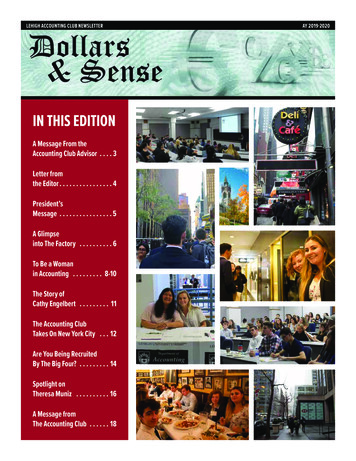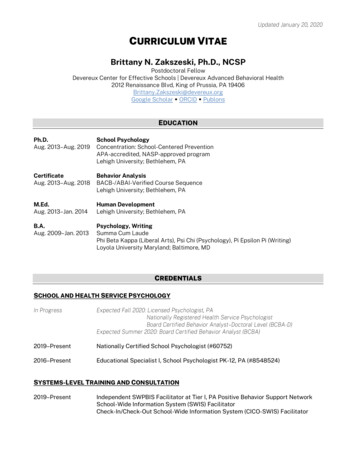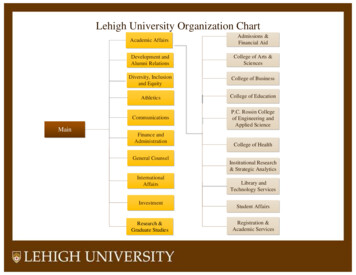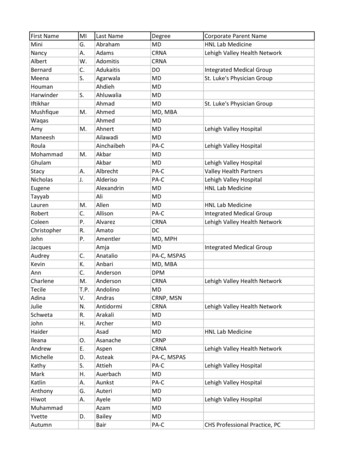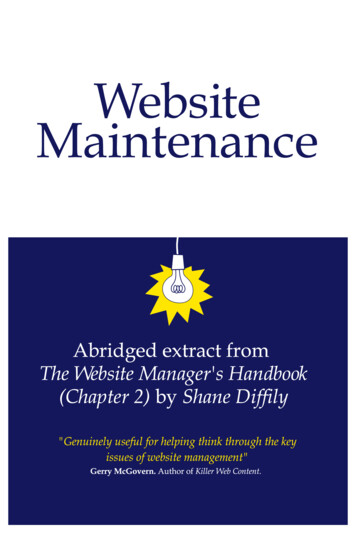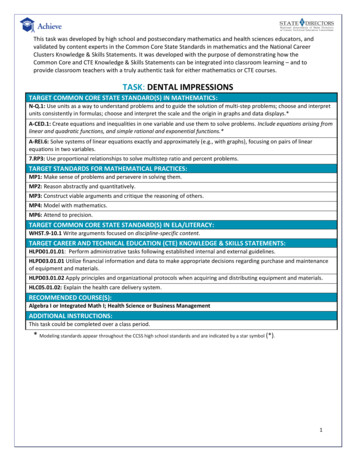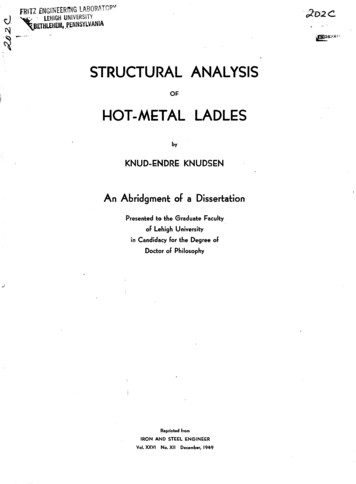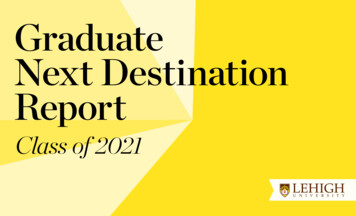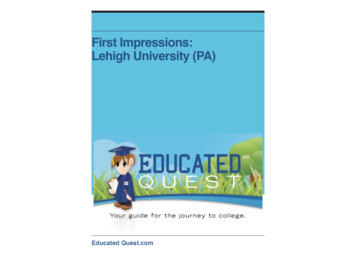
Transcription
2012-13 EditionFirst Impressions:Lehigh University (PA)Educated Quest.com
Background1Introduction to Lehigh
BackgroundFounded in 1865 after the close of the Civil War, Lehigh University opened with a 500,000 donation from Asa Packer, thePresident of the Lehigh Valley Railroad. According to Lehigh’sofficial history, Packer’s donation was the largest single contribution to an American college up to that time. In 1871 Lehighmade the decision to be tuition free and kept that commitmentfor two decades. Lehigh was organized into its three undergraduate divisions: the College of Arts and Science; the Collegeof Business Administration; and the College of Engineering in1918 and has held to this structure ever since. These undergraduate divisions became co-ed starting in 1971.With around 5,000 undergraduates, Lehigh is a smaller schoolthan most comprehensive national research universities. Because of its academic depth in the liberal arts, business and science, technology, engineering and mathematics (STEM) subjects, Lehigh is cross-shopped against larger public and privateuniversities such as Carnegie Mellon, Cornell, Penn State andVillanova as well as smaller technically-focused schools suchas Rensselaer Polytechnic Institute and Stevens Institute ofTechnology. It is also cross-shopped against Patriot Leaguesports rivals Bucknell and Lafayette, which are smaller liberalarts colleges that also offer engineering. Case Western Reserve is probably the most similar school to Lehigh in terms ofacademic programs and its organization around colleges of lib-2
eral arts, business and engineering, although it has about 1,000fewer undergraduates.According to the Office of Admissions, 38 percent of Lehigh undergraduates are enrolled in the Rossin College of Engineeringand Applied Science, 34 percent in the College of Arts and Sciences and 25 percent in the College of Business and Economics. Another three percent are enrolled in a joint program inComputer Science and Business offered through the engineering and business schools. Between the engineering and science majors, just over 40 percent of Lehigh’s graduation seniors will earn a degree in a STEM subject.rate was 76 percent for the class that entered in 2008, thoughothers take advantage of programs that it make it worthwhile tostay for an extra year to earn a master’s degree.Notable Lehigh University alumni include Lee Iacocca, formerlypresident of Ford and Chairman and CEO of Chrysler; entrepreneur and race car driver Roger Penske; and Dr. Harry J.Buncke noted Plastic Surgeon and the "Father of Microsurgery," among many others.It’s not easy to get into Lehigh. Approximately 11,500 studentsapplied for one of 1,220 spots in the class that entered this pastfall. Just over 3,900 were offered admission. Nearly half (46 percent) of the class was filled through Early Decision. Whilenearly 3,700 applicants were offered a place on the waiting list-and about a third of them accepted the offer--only two werelater offered admission. High SAT scores are not an assuranceof admission; the University turned down more than half of theapplicants who scored 1300 or higher (out of 1600) on the Critical Reading and Math sections of the test.Fortunately, those who get in stay in. Ninety-six percent of themembers of the class that entered in 2014 returned for theirsophomore year, a performance that is about the same as moreselective schools. Lehigh’s most recent four-year graduation3
Costs2Tuition and FeesScholarshipsDebt
CostsLehigh’s direct charges (tuition and fees, room and board) for 2014-15were approximately 57,000; the Total Cost of Attendance was estimatedto be around 59,000, slightly more for students enrolled in the Collegeof Engineering. The Total Cost of Attendance estimate appears to below, not allowing enough for indirect costs such as books, transportation,clothing, supplies (including software) and lab fees at a school that hasso many students pursuing STEM majors.Lehigh requires not only the FAFSA and the CSS Profile; the Universityalso asks for income tax information to help the financial aid office to render decisions. Lehigh attempts to make the award process more personal by assigning applicants their own financial aid counselor as a contact. The University can make a preliminary award to students admittedthrough Early Decision, but will expect their family to supply an updatedtax return as soon as it is completed.Lehigh practices need-blind admissions, though admits off the wait-listwill be considered on a need-aware basis. On average, according to Lehigh’s 2014-15 Common Data Set, the University met 93 percent of thedemonstrated need of the members of the freshmen class, and close to96 percent of demonstrated need across the full undergraduate studentbody, based on their estimated Total Cost of Attendance. Students whocome from families that earn less than 50,000 will have no studentloans in their financial aid packages. Those from families that earn between 50,000 and 75,000 have loans capped at 3,000 per year. Inaddition, the University hosts a Student Employment Fair to help students find campus jobs.Aside from Ivy League schools and a limited number of selective privateinstitutions, Lehigh’s financial aid practices are fairer than most colleges.5
But Lehigh also has a relatively high (about half) percentage of undergraduate students who would be considered “full pay,” and therefore donot qualify for need-based aid (including Stafford Loans) from publicsources or the University. This allows the University to better help the students who are truly needy. Lehigh has a very large endowment (approximately 1.2 billion in FY 2014) for a school of its size according to the National Association of College and University Business Officers. Lehigh’sendowment is larger than schools such as Tulane, Syracuse and Baylorthat must assist more undergraduates.In addition to need-based Lehigh Grants, the University offers full andhalf-tuition merit awards as well as smaller Dean’s Scholarships andtalent-based awards. President’s Scholars provide graduating seniors(3.75 GPA) with a tuition-free fifth year of graduate school. Betweenfive and ten percent of a freshman class is selected for merit awards.While this is low for school that welcomes more than 1,000 freshmeneach year, other schools that are cross-shopped against Lehigh such asCornell offer no merit-based awards at all.Lehigh is also a great school for the smart athlete. The university competes at the highest level in the NCAA, Division 1, in all sports excludingfootball, where it competes in the “Playoff Series” group; it offers fewerfootball scholarships than much larger schools such as Penn State. TheUniversity also offers Army and Air Force ROTC on campus, includingthe scholarship programs.took out Parent PLUS loans borrowed approximately 21,300 in 2011,according to the Chronicle of Higher Education Parent PLUS Loan database.However, Lehigh graduates, even in the liberal arts, received startingsalaries that were significantly higher than their debts. Lehigh is a morecareer-oriented university than other schools of similar size. It is also fairto state that the University makes it attractive to complete Bachelor’s andMaster’s degrees within five years, more so than most research universities. In addition, nearly half (46 percent) of the graduating seniors in2013 had no student loan debt at all. This is partly due to financial aidpolicies, a small part due to athletic and ROTC scholarships. However, aschool that fills nearly half a freshman class through Early Decision islikely to have a higher percentage of full-pay students than most others.Given Lehigh’s endowment, the high enrollments in the business schooland the STEM majors, combined with active alumni relations and aggressive career services, Lehigh could be perceived to be a “better value”than many private universities--especially for those who enter and followthrough on an academic direction quickly.Lehigh undergraduate students who earned their degrees in 2013 andhad to take out student loans had, on average, a high debt burden. According to the Project on Student Debt, the average borrower borrowedapproximately 33,300, over 6,000 more than the maximum a dependent may borrow under the Federal Stafford Loan program. Parents who6
Comforts3On-Campus HousingLocal Housing Market
ComfortsLehigh requires first and second-year students to live in Universityapproved housing. However, the University does not guarantee housingin campus past the sophomore year, unusual for a privately-supportedschool. Third, fourth and fifth-year students who do not live in fraternitiesor sororities must enter a housing lottery, or move off campus. Overall,just over two-thirds of the student body lives on campus, including thefraternity and sorority houses. Greek life attracts 40 percent of the undergraduate men, 45 percent of the women, high for any college or university.Lehigh has some housing practices that are different from other selectiveschools. For example, the University provides separate substance-freehousing for first-year students as well as upper-class students. Thereare residence halls and apartment living options for students who keepKosher. Lehigh also allows second-year students to live in fraternity andsorority houses; the pledge process can begin during the second semester of the freshman year. Since the houses are on campus, the University provides essential services and imposes maximum occupancy policies.Fortunately, Bethlehem has low off-campus housing costs. The University’s online database, run through Places4Students, showed a sufficientnumber of listings, either in apartment complexes or shared houses, forjust under 400 per person per month, some including utilities. The lowhousing costs in the community make it attractive for students to moveoff campus, especially if they have employment, research or study opportunities during the summer.8
Community4CampusEnvironsSchool Spirit
CommunityLehigh’s campus community has to consider not only Bethlehem; it also needs toconsider the region, the Lehigh Valley. There are at least as many entertainment andrecreational opportunities in the Valley as there are in a college community dominated by a very large public university such as Penn State--as long as you have access to transportation to get to them.The University has the facilities, including the Zoellner Arts Center, to attracted notable speakers and entertainers to campus as well as many clubs and organizations.However, the Greek system is a more important part of the campus social life than itis at larger selective private universities as well as technically-focused schools suchas Case Western or Carnegie Mellon. Lehigh has “ranked” high as a “party school” inthe Princeton Review, a startling contrast for a demanding academic institution.Lehigh has a very attractive main quad, complemented by some impressive modernbuildings for the business school (Rauch) and the Campus Square but also a moreutilitarian science and engineering complex. The main campus is easily navigable.However it is stacked upon a hill. The walks that might be pleasant early and late inthe school year could be far less pleasant in the winter months. Fortunately, Lehighprovides a van service to help students, faculty and staff get around.Reported incidents of crime in Lehigh University’s most recent Clery Report are fairlylow, considering the size of the student body and the location of the campus. Liquorlaw violations are, by far, the most reported crimes, and they trended down between2011 and 2013. There was only one reported incidence of either forcible or nonforcible sexual assault between 2011 and 2013, unusual for any college or universityof any size in any location.Lehigh competes in the Patriot League in 24 sports. Within Pennsylvania only PennState competes in more sports at the Division 1 (scholarship) level. Lehigh’s footballrivalry with nearby Lafayette College reached its 150th anniversary this past season,though Lafayette, a Patriot League rival, is a much smaller school. Lehigh has alsoenjoyed recent success in men’s basketball, lacrosse and wrestling (which is not aPatriot League sport). In 2012, Lehigh’s men’s basketball team, seeded 15th in theirregional in the NCAA Tournament, upset Duke, a 2nd seed.10
Curriculum5AcademicsHonors ProgramsExperiential Learning
CurriculumLehigh comes quite close to offering the breadth of a larger university in a mid-sized package and also asks its students totake on a similarly demanding five-course load depending onthe academic program they choose. However, the Universityalso makes it easier to change schools or enter one of theschools undecided than a larger public or private university. Entering students do not need to declare a major, unless they areinterested in one of the integrated degree programs (Businessor Liberal Arts and Engineering, Business and Computer Science). But they must remain enrolled in the college they choosewithin Lehigh for at least one year. Lehigh also offers enrollment in South Mountain College which substitutes facultydesigned multi-disciplinary classes for the more traditional liberal arts distribution requirements. Further, Lehigh offers tremendous opportunities for independent study and research inside and outside of a honors program.The options and programs within majors are astonishing for aschool of Lehigh’s size. A Marketing major, for example, has achoice among five different concentrations. Finance majorsmay receive optional instruction at no charge to learn the software packages used by investment analysts on Wall Street.Business students can collaborate with STEM students on product development projects for area businesses ranging fromstart-ups formed by Lehigh alumni to the region’s major naturalgas utility. Or they can spend time meeting alumni and venture12
capitalists in Silicon Valley, It is very easy, for example, for a liberal arts major to develop a business minor or the business student to double major in a liberal arts subject. Those who are interested in business or liberal arts and engineering maychoose, if selected, the integrated program with general engineering course or a five-year dual degree with a business or liberal arts major and a major in one of the engineering disciplines. Lehigh also offers some liberal arts programs that arenot found at liberal arts colleges including art, architecture anddesign, cognitive science and sustainable development. Lehighalso offers co-op for engineering students which provides up tonine months of paid full-time employment while still allowingthem to graduate in four years.than 100 according to the University’s most recent CommonData Set. Larger introductory courses help to create a settingthat could be more competitive than cooperative for first-yearstudents, especially given the appeal of many of the majors andintegrated programs. But help is available. It is wise to seek itearly, if needed.Lehigh students gave their faculty a rating of 3.68 (out of a possible five points) on RateMyProfessors.com about the same asstudents at the University of Rochester (3.7) and Case Western(3.67) rated their faculty but lower than students at PatriotLeague rivals Bucknell (3.84) and Lafayette (3.82) rated theirs.In addition to the undergraduate degree programs, Lehigh offers a five-year Bachelors-Masters program in Education aswell as joint degree programs in medicine (with Drexel University), dentistry (with Penn) and osteopathy (with the State University of New York).But Lehigh, while having tremendous academic depth, has itsdownsides. The popularity of the business and STEM programsmeans larger introductory courses in subjects such as Biology,Chemistry, Economics, Math and Physics while the school is becoming more demanding at accepting AP credits. Sixteen percent of Lehigh’s 910 class sections enrolled more than 40 students in the previous academic year, with 30 enrolling more13
Connections6Alumni RelationsCareer Services
ConnectionsAmong the nearly 41,000 Lehigh alumni registered on LinkedIn.com,over 20,000 live and/or work in the New York or Philadelphia metropolitan areas or in the Lehigh Valley. Lehigh’s location makes it easy foralumni to come to campus or for students to knock on doors in theseplaces. There are also just over 1,800 alumni in the Boston area, around1,700 in and around Washington DC as well as just under 1,200 in andaround San Francisco. About a quarter of Lehigh alumni make a contribution to the University, higher than more selective schools such as Carnegie Mellon, NYU, Tufts and Washington University in St. Louis, all ofwhich have more undergraduate students and alumni, according to the2015 U.S. News Best Colleges guide.Lehigh graduates have tremendous success immediately after they complete their degrees. According to the First Destination Report producedby the University’s Office of Career Services, 66 percent of the membersof the Class of 2013 found full-time employment within one year ofgraduation while 29 percent were enrolled in graduate or professionalschool. Eighty four percent of the graduates of the College of Businessand Economics were working full-time as were just over half of the graduates of the College of Arts and Sciences and two thirds of the graduatesof the engineering school. Just over 200 employers conducted 2,500 oncampus interviews alone while more than 1,100 employers posted morethan 3,700 co-ops, internships and full-time jobs. More than 40 percentof 2013 graduates found their first jobs through Career Services. Justover a fifth were hired full-time following a co-op or internship they hadheld while in school. And most of those working--88 percent of the classresponded to the survey--earned salaries higher than the amounts theymight have borrowed for student loans.15
Conclusions7Summing up
ConclusionsTake a large university, including the engineering and business programs, pare it down to 5,000 undergraduates and you get Lehigh. Fewschools offer so many options, even larger private and public universitiesthat have more famous names. And few schools, public or private, haveas loyal an alumni base. Work hard at Lehigh and you can go anywhere,even the same places as Ivy League graduates expect to go.The depths of the career-oriented programs are as much a weakness asthey are a strength. It is too easy to be drawn into an education whereyou could be studying all the time or lured into a social life where you believe that you do not have to study to succeed here. It takes a special student to succeed at Lehigh. That same student might also be at Bucknellor Penn State, one of the larger Ivies, Penn or Cornell, or a moretechnically-focused school such as Carnegie Mellon, Case Western orRochester. These schools, while different in location and setting, havethe same competitive climate. You can make friends here, but you mustcome ready to work, especially in the introductory courses. The variousdegree options allow better students will delve deep into STEM or business problems, many that are “real world,” work in good-paying co-opsor internships, even earn a free year of graduate school. But the less prepared may really struggle.Lehigh has two “image problems” that are not linked to Ivies or other private universities that are strong in business and STEM such as CaseWestern or Carnegie Mellon, nor to mid-sized schools such as Villanovathat offer similar degree options. The first problem is that Lehigh has ahigh rank in “party school” surveys. While that has not stopped excellentstudents from finding employment or gaining admission to graduate orprofessional schools, nor has it hurt alumni loyalty, it compromises the17
University administration in any efforts they make to have the schooltaken more seriously as a national research university.Walk around this campus and you will see facilities that are as impressive as any you might find at a school without the “party school” label aswell as larger public universities that do. Yet Lehigh is not listed amongthe membership of the Association of American Universities--although itis deserving of such recognition. Lehigh matches up closely in undergraduate student body size with schools such as Case Western, Dartmouth, Princeton, Rice and Rochester while also offering more comprehensive undergraduate business and computer science programs thanany of these institutions as well as an equally impressive engineeringschool.The second issue is the surrounding neighborhood. While Lehigh has avery attractive campus, especially its main green, the surrounding areahas many rough edges after you go downhill. The Lehigh Valley offersmuch for college students to do as well as many entrepreneurial opportunities for Lehigh students. But Bethlehem, while it has a reviving downtown and a very nice historic district, is not a college town unto itself.Lehigh is powerfully appealing to exceptionally bright and career-orientedpeople who want the offerings of a larger school but not the huge classesin the upper-division courses. Lehigh students appear to receive a verygood return on their investment as well as their educational experience.Lee Iacocca had the choice to invest his money in Lehigh, where heearned his bachelor’s degree, or Princeton, where he earned his masters. He banked on Lehigh. That’s quite a recommendation from anAmerican business hero.Ed Quest’s Report CardLehigh UniversityFour-Year/Six-YearGrad ulumConnectionsA/AAB B B AAStrengthsWeaknessesPretty much anything you can find at alarger school (even an Ivy) is here in a midsized packageIf you don’t want a school with a largeGreek population, look elsewhereLoyal alumni base, including Lee Iacocca,among others, and effective careerservices.Bethlehem has some nice neighborhoods,but they’re not right by the campus.One of the best schools to test variouscareer options in business or engineering,including entrepreneurship. Engineers canalso do co-op and graduate in four years.“Party school” label might have hurt thisschool in its moves to be taken moreseriously as a research university.Great school for a smart athlete who wantsa scholarship (Patriot League)--and theyeven beat Duke in NCAA Tournament play!Merit awards do not go far down into afreshman class.There’s more for college students to do inthis metro area than people think--and NewYork and Philadelphia are not far away!You might have to live in a triple room inyour first year.Financial aid policies are fair, though abouthalf of the students are full-payThe University cannot guarantee housingpast the sophomore year, unusual for aprivate research-oriented schoolEasy to shift out of engineering into liberalarts or business and still graduate in fouryears--or you can do a dual or combineddegree, even get a year of grad school forfree!The University’s estimate for Total Cost ofAttendance appears low, though the schoolreports meeting a very high percentage offinancial need18
The End8To receive notices aboutnew and updated profilesvisitwww.EducatedQuest.com
This allows the University to better help the stu-dents who are truly needy. Lehigh has a very large endowment (approxi-mately 1.2 billion in FY 2014) for a school of its size according to the Na-tional Association of College and University Business Officers. Lehigh's endowment is larger than schools such as Tulane, Syracuse and Baylor
